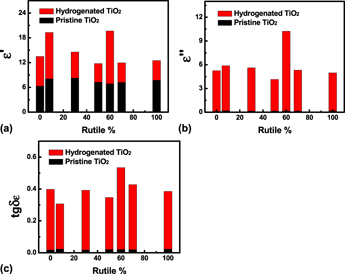Crossref Citations
This article has been cited by the following publications. This list is generated based on data provided by
Crossref.
Tian, Lihong
Yan, Xiaodong
Xu, JiLian
Wallenmeyer, Petra
Murowchick, James
Liu, Lei
and
Chen, Xiaobo
2015.
Effect of hydrogenation on the microwave absorption properties of BaTiO3 nanoparticles.
Journal of Materials Chemistry A,
Vol. 3,
Issue. 23,
p.
12550.
Yan, Xiaodong
and
Chen, Xiaobo
2015.
Encyclopedia of Inorganic and Bioinorganic Chemistry.
p.
1.
Dong, Junye
Ullal, Rohan
Han, Jie
Wei, Shanghai
Ouyang, Xin
Dong, Junzhe
and
Gao, Wei
2015.
Partially crystallized TiO2 for microwave absorption.
Journal of Materials Chemistry A,
Vol. 3,
Issue. 10,
p.
5285.
Xia, Ting
Cao, Yinghui
Oyler, Nathan A.
Murowchick, James
Liu, Lei
and
Chen, Xiaobo
2015.
Strong Microwave Absorption of Hydrogenated Wide Bandgap Semiconductor Nanoparticles.
ACS Applied Materials & Interfaces,
Vol. 7,
Issue. 19,
p.
10407.
Chen, Xiaobo
Liu, Lei
and
Huang, Fuqiang
2015.
Black titanium dioxide (TiO2) nanomaterials.
Chemical Society Reviews,
Vol. 44,
Issue. 7,
p.
1861.
Wan, Gengping
Yu, Lei
Peng, Xiange
Wang, Guizhen
Huang, Xianqin
Zhao, Haonan
and
Qin, Yong
2015.
Preparation and microwave absorption properties of uniform TiO2@C core–shell nanocrystals.
RSC Advances,
Vol. 5,
Issue. 94,
p.
77443.
Li, Kexue
Xu, Jilian
Yan, Xiaodong
Liu, Lei
Chen, Xiaobo
Luo, Yongshi
He, Jun
and
Shen, D. Z.
2016.
The origin of the strong microwave absorption in black TiO2.
Applied Physics Letters,
Vol. 108,
Issue. 18,
Yang, Peipei
Liu, Ying
Zhao, Xiuchen
Cheng, Jingwei
and
Li, Hong
2016.
Electromagnetic wave absorption properties of FeCoNiCrAl0.8 high entropy alloy powders and its amorphous structure prepared by high-energy ball milling.
Journal of Materials Research,
Vol. 31,
Issue. 16,
p.
2398.
Yan, Xiaodong
Tian, Lihong
Tan, Xinyu
Zhou, Minjie
Liu, Lei
and
Chen, Xiaobo
2016.
Modifying oxide nanomaterials’ properties by hydrogenation.
MRS Communications,
Vol. 6,
Issue. 3,
p.
192.
Zhou, Minjie
Hou, Zhaohui
Zhang, Li
Liu, Yan
Gao, Qiongzhi
and
Chen, Xiaobo
2017.
n/n junctioned g-C3N4 for enhanced photocatalytic H2 generation.
Sustainable Energy & Fuels,
Vol. 1,
Issue. 2,
p.
317.
Menon, Aishwarya V.
Madras, Giridhar
and
Bose, Suryasarathi
2017.
Magnetic Alloy‐MWNT Heterostructure as Efficient Electromagnetic Wave Suppressors in Soft Nanocomposites.
ChemistrySelect,
Vol. 2,
Issue. 26,
p.
7831.
Liu, Yan
Tian, Lihong
Tan, Xinyu
Li, Xin
and
Chen, Xiaobo
2017.
Synthesis, properties, and applications of black titanium dioxide nanomaterials.
Science Bulletin,
Vol. 62,
Issue. 6,
p.
431.
Nechiyil, Divya
Muruganathan, Manoharan
Mizuta, Hiroshi
and
Ramaprabhu, Sundara
2017.
Theoretical Insights into the Experimental Observation of Stable p-Type Conductivity and Ferromagnetic Ordering in Vacuum-Hydrogenated TiO2.
The Journal of Physical Chemistry C,
Vol. 121,
Issue. 26,
p.
14359.
Ji, Xuqiang
Zhang, Wenling
Jia, Wenpeng
Wang, Xiaoxia
Tian, Yu
Deng, Li
and
Liu, Jingquan
2017.
Cactus-like double-shell structured SiO 2 @TiO 2 microspheres: Fabrication, electrorheological performances and microwave absorption.
Journal of Industrial and Engineering Chemistry,
Vol. 56,
Issue. ,
p.
203.
Tian, Lihong
Murowchick, James
and
Chen, Xiaobo
2017.
Improving the activity of CoxP nanoparticles for the electrochemical hydrogen evolution by hydrogenation.
Sustainable Energy & Fuels,
Vol. 1,
Issue. 1,
p.
62.
Tian, Lihong
Xu, Jilian
Just, Michael
Green, Michael
Liu, Lei
and
Chen, Xiaobo
2017.
Broad range energy absorption enabled by hydrogenated TiO2 nanosheets: from optical to infrared and microwave.
Journal of Materials Chemistry C,
Vol. 5,
Issue. 19,
p.
4645.
Ullattil, Sanjay Gopal
Narendranath, Soumya B.
Pillai, Suresh C.
and
Periyat, Pradeepan
2018.
Black TiO2 Nanomaterials: A Review of Recent Advances.
Chemical Engineering Journal,
Vol. 343,
Issue. ,
p.
708.
Green, M.
Liu, Z.
Xiang, P.
Tan, X.
Huang, F.
Liu, L.
and
Chen, X.
2018.
Ferric metal-organic framework for microwave absorption.
Materials Today Chemistry,
Vol. 9,
Issue. ,
p.
140.
Green, Michael
Tian, Lihong
Xiang, Peng
Murowchick, James
Tan, Xinyu
and
Chen, Xiaobo
2018.
FeP nanoparticles: a new material for microwave absorption.
Materials Chemistry Frontiers,
Vol. 2,
Issue. 6,
p.
1119.
Ma, Sicong
Huang, Si-Da
Fang, Ya-Hui
and
Liu, Zhi-Pan
2018.
TiH Hydride Formed on Amorphous Black Titania: Unprecedented Active Species for Photocatalytic Hydrogen Evolution.
ACS Catalysis,
Vol. 8,
Issue. 10,
p.
9711.



